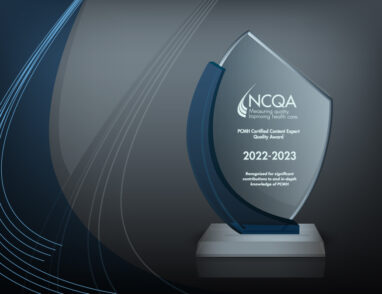PCMH Annual Reporting 2022: New Method, New Opportunities
November 30, 2021 · NCQA Communications
What’s the Big Idea?
Primary care practices that have earned NCQA Patient-Centered Medical Home (PCMH) Recognition will use a new way to submit their Annual Reporting data to NCQA, starting January 1, 2022: Recognized practices will upload all performance data through the new Measure Reporting tile on the Organization Dashboard in Q-PASS.
Practices that have not yet earned the PCMH seal—that is, practices in the Transform stage of PCMH Recognition—will be able to use this new way to upload data, starting in late 2022.
Standardized measures required in 2022?

No. NCQA encourages—but does not require—practices to submit standardized measures.
Over time, we hope and expect standardized measures will become the norm for PCMH and for other programs inside and outside NCQA.
Seventeen of the most common standardized measures are listed below and in Appendix 5 of our PCMH Standards and Guidelines. Those 17 are not the only standardized measures practices may use. They’re just the ones most practices choose.
Practices that do not collect standardized measures may still report using the Custom Measure option. See pages 89-90 of the Standards and Guidelines for details. If you go the Custom Measure route, make sure you choose measures that fit the required measure categories.
Why report standardized measures?
The rise of value-based based contracting and streamlining of quality reporting mean, in a few years, collecting and reporting standardized measures will become, well, standard.
Short- and medium-term advantages of using standardized measures include:
- Consistency: Relying on standardized measures helps practices collect data in uniform, reliable ways. The measures’ reporting parameters reduce potential measurement bias.
- Efficiency: Because diverse programs at NCQA and elsewhere use standardized measures, using standardized measures for PCMH Annual Reporting can reduce reporting burden for practices. For example, people at practices reporting data for PCMH Recognition, NCQA Diabetes Recognition and NCQA Heart-Stroke Recognition save time and effort if they use standardized measures.
- Comparability: Apples-to-apples comparisons between practices are possible when practices use standardized measures. Standardized measures helps practices benchmark performance against peers—something that will be increasingly common as reimbursements become more value-based.
- Credibility: Using standardized measures helps practices gain experience reporting measures for value-based payment programs. Over time, programs like NCQA PCMH Recognition that use standardized measures may stand out as more credible, since their results allow comparisons to practices within and beyond PCMH. This increases the value of your performance and your PCMH Recognition.
How can practices start using standardized measures?
Download and follow these two documents:
Be sure to follow the measure specifications outlined by the measure steward—the organization that makes manages each measure. Appendix 5 of our PCMH Standards and Guidelines shows that NCQA and CMS are measure stewards of the 17 standardized measures mentioned earlier.
Wondering what reporting period to use? We recommend January 1 to December 31 of the prior calendar year. Practices can use a custom reporting period if a full calendar year is not available.
The bottom line
- To NCQA-Recognized PCMHs that have been collecting data for the last year, we say: Keep doing what you’re doing! Your data collection remains the same.
- The only thing that’s changing is how NCQA-Recognized PCMHs submit all data to NCQA for Annual Reporting.
- This new way to upload data and using standardized measures can streamline data submissions and nudge medical homes toward the future of quality reporting. Adopting standardize measures makes PCMH Recognition more valuable and meaningful for practices and patients.








